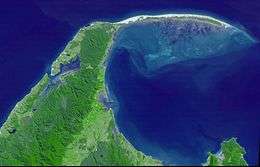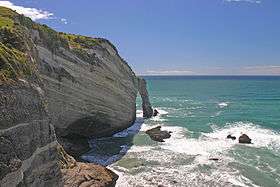Cape Farewell, New Zealand
Cape Farewell is a headland in New Zealand, the most northerly point on the South Island. It is located just west of Farewell Spit. First mapped by Abel Tasman, it was named by British explorer Captain James Cook in 1770 —it was the last land seen by his crew as they departed on the ship's homeward voyage.[1]
| Cape Farewell | |
|---|---|
 | |
| Location | South Island, New Zealand |
| Coordinates | 40°29′54″S 172°41′01″E |
| Offshore water bodies | Tasman Sea |
| Area | Oceania |
Owing to its remote location it is one of the less visited of New Zealand's major capes. The "Clifftop walk" (2–3 hours one-way along the heights of the coast East of the cape) joins the area with the beginning of Farewell Spit, and has stunning vistas of the Tasman Sea to one side, of the sand dunes in the northeast and of the towering cliffs and rocky, primal landscapes to the shoreward (east) side.
In 2020, the northern-most 2.5 hectares of the cape was enclosed by a predator-proof fence to protect seabirds, rare native plants, giant snails and geckos.[2]
 Cape Farewell area satellite image. The cape is the topmost land to the west of the sandy spit. |
 Cape Farewell Arch from viewing platform. |
Geology
The cape and its cliffs are composed of Paleocene quartz sandstones.[3]. The erosion of the cliffs into fine sand carried on the sea currents creates Farewell Spit further east.[1]
References
- Farewell Spit and Cape Farewell (from Te Ara: The Encyclopedia of New Zealand, 1966 Edition. Accessed 2008-06-16.)
- "Predator-free sanctuary for seabirds, rare native plants opens at Cape Farewell". RNZ. 18 January 2020. Retrieved 20 January 2020.
- J.J., Kamp, Peter; A., Vincent, Kirsty; J.S., Tayler, Michael (2015). "Cenozoic sedimentary and volcanic rocks of New Zealand: A reference volume of lithology, age and paleoenvironments with maps (PMAPs) and database". Cite journal requires
|journal=(help)